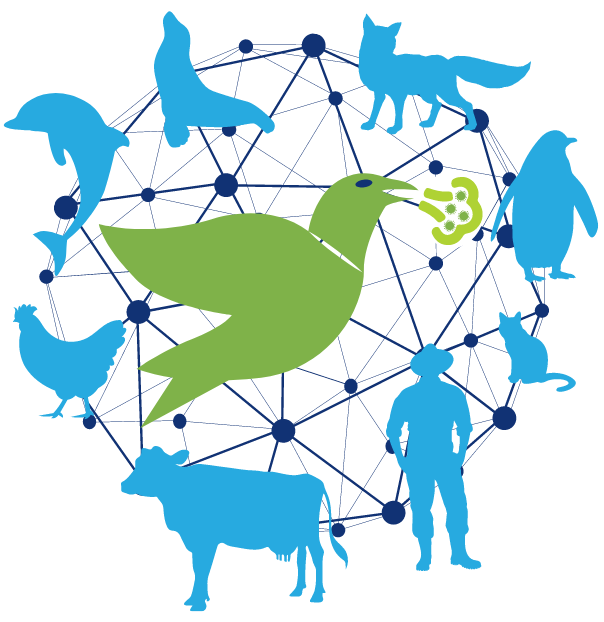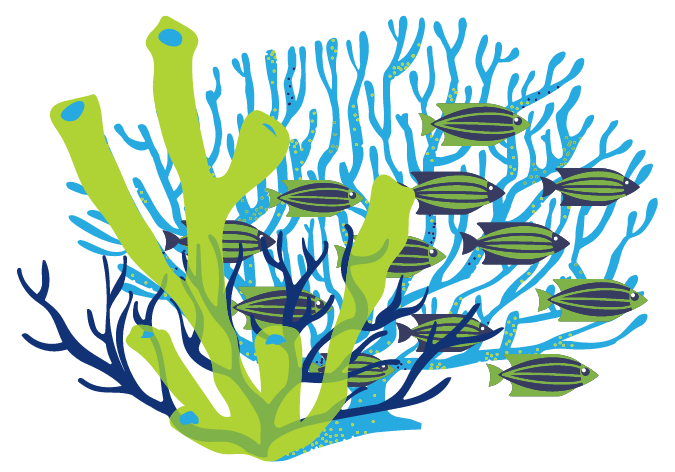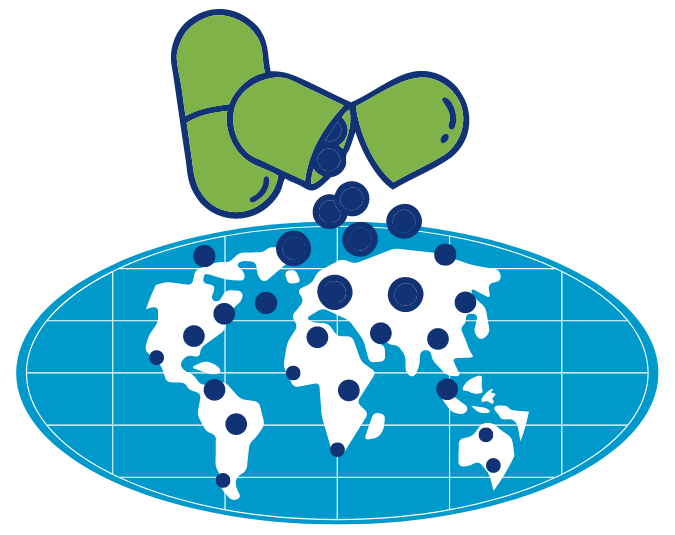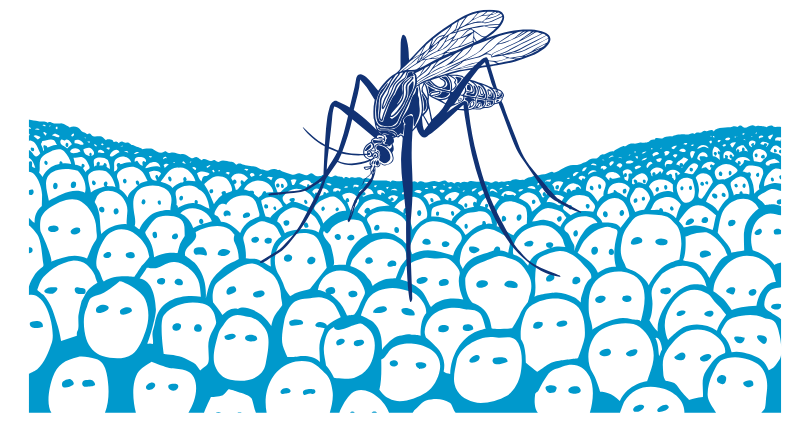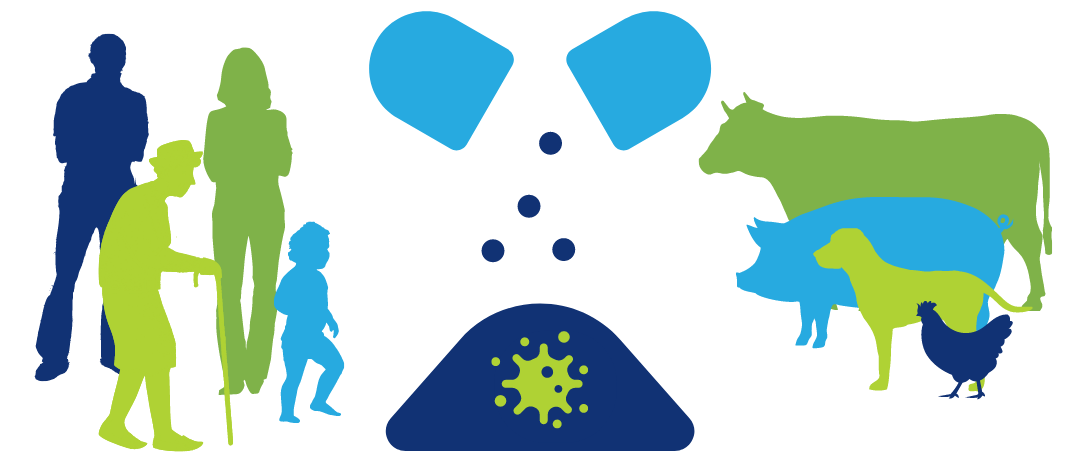
Drug-resistant superbugs are killers, and the problem is getting worse even as people become aware of the need to control how we use antibiotics.
Researchers estimate close to five million people died in 2019 because of antibiotic-resistant bacteria alone. Yet, doctors continue to overprescribe these lifesaving drugs and farmers continue to give them to livestock and fish not only to treat and prevent disease but to help them grow faster.
Now, a team of experts has shown clear links between the use of antibiotics in people and in animals.
Kasim Allel of the London School of Hygiene & Tropical Medicine and University College London and colleagues showed that the more antibiotics were used in people, the higher the rates of antibiotic-resistant bacteria in animals, and vice versa.
But overuse is not the only culprit.
Kasim’s team also found rates of antimicrobial resistance are worse in poorer countries. Sanitation and a lack of health care are both likely factors. Governments will have to do more to control antimicrobial resistance than simply limiting the use of these drugs.
Listen as Kasim explains the many different factors that are driving the rise of drug-resistant superbugs.
Maggie Fox
Hello and welcome to One World, One Health with the latest ideas to improve the health of our planet and its people. I’m Maggie Fox. Our planet and all of us are battling problems such as pollution, climate change, and new and reemerging infectious diseases, and they’re all linked. This podcast is brought to you by the One Health Trust, with bite-sized insights into ways to help.
Antibiotic resistance is a huge problem, with drug-resistant bacteria alone killing more than a million people every year. Misuse and overuse of antibiotics to treat human disease is a major factor. But it’s not the only factor. Farmers and other food producers also feed antibiotics to livestock, and that can help the evolution of superbugs as well.
Infectious disease specialist Kasim Allel of the London School of Hygiene and Tropical Medicine and colleagues recently did a study that showed this evolution of drug resistance goes both ways. The more antibiotics people use, the more antibiotic resistance is seen in the human population and in animal populations. And the same goes for animals. The more antibiotics are fed to animals, the more antibiotic resistance is seen in both humans and in livestock.
In this episode, we’re chatting with Kasim about what he and his colleagues have found. Kasim, thanks so much for joining us.
Kasim Allel
Thank you so much for inviting me.
Maggie Fox
How is antibiotic resistance transmitted to people by the animals they’re in contact with?
Kasim Allel
The transmission from animals to humans would be by three different sources, I’ll say. The first one will be via direct contact between animals and humans.
Secondly, I’ll say that the transmission between animals to humans could occur through the consumption of antibiotic residues and meat. And it’s basically when on farms, antibiotic treatments are not stopped at the correct time.
And then thirdly, which is the last way of transmission between animals [and] humans, would be when the antibiotic resistant bacteria is present in meat, and it can transfer antibiotic resistance into human bacteria, for example. The risk of this to occur is very low due to different features, but mainly because of high cooking temperatures [which] kill these bacteria. But there [are] just like a couple of cases when it’s actually very difficult to kill them, and it’s because of the different resistant mechanisms that some bacteria have developed over time.
Maggie Fox
You also found that the problem is bigger in low- and middle-income countries. Can you talk about why that is?
Kasim Allel
Just try to think about the political, economic, social, cultural, and environmental forces that shaped these nations. For example, in low- and middle-income countries (LMICs), there [are] some underlying factors, including living in poverty, having poor hygiene and sanitation, and having limited access to healthcare. So this might act as a, let’s say, motor for antibiotic-resistant bacteria to survive. So then this is crucial in these types of settings.
Also, in LMICs, low- and middle-income countries, there are some sort of difficulties or challenges when it comes to implementing surveillance of antibiotic-resistant bacteria, and also there is [a] lack of monetary resources and infrastructure. And as you probably know, to test antibiotic resistant bacteria, you need to apply antibiotic susceptibility testing, which can be a bit expensive for some countries, and specifically those [that] are low-income. And also you want to trace, for example, where the bacteria originated, but [it’s] very difficult, and it requires sequencing techniques, and that’s actually very, very expensive. I’ll say that most low- and middle-income countries cannot afford these types of instruments.
Maggie Fox
So what you’re saying is that you can’t really track it, and so it can spread undetected and the countries can’t do anything about it.
Kasim Allel
Yeah, because of their surveillance capacities basically, and also because of the lack of infrastructure. Also, because of these, there is reduced control regarding mandatory prescriptions, for example. In most highly developed nations, you see that you require a prescription in order to get antibiotics, but in low- and middle-income countries, the regulation is not that solid, let’s say, it’s not that mandatory, and there [are] even informal markets where you can access antibiotics and also over the counter. Yeah, this is something serious and [it] happens quite frequently in low- and middle-income countries.
Maggie Fox
So are farmers and food producers in these less wealthy countries more likely in the first place to feed antibiotics to their livestock?
Kasim Allel
When it comes to high income settings, we see that the use of antibiotics as growth promoters is prohibited. But in many, many low- and middle-income countries, the usage of antibiotics as growth promoters, it’s something that is actually happening on the farm. So again, you can use antibiotics, they are relatively cheap for them, for the farm owners, and then they can have more meat in the very end so they can sell more meat to the people basically. This is one of the practices, I’ll say, that needs to be eradicated. But yeah, it’s highly prevalent in some low-income countries.
Also, on farms, there is the prophylactic use of antibiotics. By this, I mean that some antibiotics are used as a precaution to prevent infection, because let’s imagine that we are on a farm. Basically, you have got a flock of animals. If I get infected, I’m probably going to transmit the bacteria to all others. In order to prevent that [from happening], farm owners tend to use antibiotics as a prevention basically. But again, this practice, I’d say it’s not prevalent in high-income countries. And again, I’ll say that the WHO, with some other organizations, are working on these in low- middle-income settings in order to eradicate this.
Maggie Fox
What are some of the answers? I think you found that good governance was a factor. Can you tell us what that looks like?
Kasim Allel
Political instability and corruption make the system unstable. Let’s say that less effective controls of antibiotic use, not only in people here but also in the animal sector, would be strictly related to higher antibiotic resistance rates. By this I mean, for example, less supervision and enforcement on floors…would be strictly related to higher antibiotic resistance rates, again, in humans and animal species.
Also, we found that inequalities, so highly unequal countries, and also those countries where private hospitals are predominant, are also related [to] reduced supervision, uncontrolled, of antibiotic-resistant bacteria. Again, the more chaos you see in a country, the less stringent policies they will have. So then that may affect antibiotic resistance as well.
According to the WHO (World Health Organization), approximately 150 countries have developed their national action plans to combat and tackle antibiotic resistance. There is a necessity for a collaborative and multisectoral approach when it comes to tackling antibiotic resistance. It’s not even enough to look at the local, but also at the regional, national and global levels, with the main objective of achieving optimal antibiotic resistance surveillance and control.
Maggie Fox
So what should the average person know about this? What would be your message to the average person listening to this podcast?
Kasim Allel
The main message [from] me and my colleagues would be that we need to acknowledge that there is an interconnection between animals, humans, environment, and government structures. In order to tackle antibiotic resistance, we need to work collaboratively in order to launch and set the appropriate and accurate policies in the near future.
Maggie Fox
Kasim, thank you so much for an informative chat.
Kasim Allel
Thank you so much, Maggie.
Maggie Fox
If you liked this podcast, which is brought to you by the One Health Trust, please share it by email or your favorite social media platform. And let us know what else you’d like to hear about at [email protected]. Thanks for listening.
Ramanan Laxminarayan
Thank you for listening to One World, One Health brought to you by the One Health Trust. I’m Ramanan Laxminarayan, founder and president of the One Health Trust. You can subscribe to One World, One Health on Spotify, Apple Podcasts, or wherever you listen to podcasts. Follow us on social media at @onehealthtrust, one word, for updates on One World, One Health and the latest in research on One Health issues like drug resistance, disease spillovers, and the social determinants of health. Finally, please do consider donating to the One Health Trust to support this podcast and other initiatives and research that help us promote health and wellbeing worldwide. Until next time.
Transcribed by https://otter.ai
Maggie Fox
Hola y bienvenido a One World, One Health con las últimas ideas para mejorar la salud de nuestro planeta y su gente. Soy Maggie Fox. Nuestro planeta y todos nosotros estamos luchando contra problemas como la contaminación, el cambio climático y las enfermedades infecciosas nuevas y reemergentes, y todos están relacionados. Este podcast es presentado por One Health Trust, con información breve sobre formas de ayudar.
La resistencia a los antibióticos es un problema enorme: sólo los gérmenes resistentes a los medicamentos matan a más de un millón de personas cada año. El mal uso y el uso excesivo de antibióticos para tratar enfermedades humanas es un factor importante. Pero no es el único factor. Los agricultores y otros productores de alimentos también alimentan al ganado con antibióticos, lo que también puede ayudar a la evolución de los super gérmenes.
El especialista en enfermedades infecciosas Kasim Allel, de la Escuela de Higiene y Medicina Tropical de London, y sus colegas realizaron recientemente un estudio que demostró que esta evolución de la resistencia a los medicamentos va en ambos sentidos. Cuantos más antibióticos usa la gente, más resistencia a los antibióticos se observa en la población humana y en las poblaciones animales. Y lo mismo ocurre con los animales. Cuantos más antibióticos se administran a los animales, más resistencia a los antibióticos se observa tanto en los humanos como en el ganado.
En este episodio, charlamos con Kasim sobre lo que él y sus colegas encontraron. Kasim, muchas gracias por acompañarnos.
Kasim Allel
Muchas gracias por invitarme.
Maggie Fox
¿Cómo se transmite la resistencia a los antibióticos a las personas a través de los animales con los que están en contacto?
Kasim Allel
La transmisión de animales a humanos se produciría por tres fuentes diferentes, diría yo. El primero será mediante el contacto directo entre animales y humanos.
En segundo lugar, diré que la transmisión entre animales y humanos podría ocurrir a través del consumo de residuos de antibióticos y carne. Y es básicamente cuando en las granjas los tratamientos antibióticos no se suspenden en el momento adecuado.
Y luego, en tercer lugar, que es la última forma de transmisión entre animales [y] humanos, sería cuando las bacterias resistentes a los antibióticos están presentes en la carne y pueden transferir la resistencia a los antibióticos a las bacterias humanas, por ejemplo. El riesgo de que esto ocurra es muy bajo debido a las diferentes características, pero principalmente debido a las altas temperaturas de cocción [que] matan estas bacterias. Pero hay un par de casos en los que en realidad es muy difícil matarlas, y se debe a los diferentes mecanismos de resistencia que algunas bacterias han desarrollado con el tiempo.
Maggie Fox
También descubrió que el problema es mayor en los países de ingresos bajos y medios. ¿Puedes hablarnos de por qué es así?
Kasim Allel
Intente pensar en las fuerzas políticas, económicas, sociales, culturales y ambientales que dieron forma a estas naciones. Por ejemplo, en los países de ingresos bajos y medianos (PIBM), existen algunos factores subyacentes, como vivir en la pobreza, tener malas condiciones de higiene y saneamiento y tener un acceso limitado a la atención médica. Entonces, esto podría actuar como, digamos, un motor para que sobrevivan las bacterias resistentes a los antibióticos. Entonces esto es crucial en este tipo de entornos.
Además, en los países de ingresos bajos y medianos, países de ingresos bajos y medianos, existen algún tipo de dificultades o desafíos cuando se trata de implementar la vigilancia de bacterias resistentes a los antibióticos, y también hay [una] falta de recursos monetarios e infraestructura. Y como probablemente sepa, para probar bacterias resistentes a los antibióticos, es necesario aplicar pruebas de susceptibilidad a los antibióticos, lo que puede resultar un poco costoso para algunos países, y específicamente para aquellos [que] son de bajos ingresos. Y también se quiere rastrear, por ejemplo, dónde se originó la bacteria, pero es muy difícil y requiere técnicas de secuenciación, lo que en realidad es muy, muy costoso. Diré que la mayoría de los países de ingresos bajos y medios no pueden permitirse este tipo de instrumentos.
Maggie Fox
Entonces, lo que estás diciendo es que realmente no se puede rastrear, por lo que puede propagarse sin ser detectado y los países no pueden hacer nada al respecto.
Kasim Allel
Sí, básicamente por sus capacidades de vigilancia, y también por la falta de infraestructura. Además, a causa de ello, hay un control reducido respecto de las recetas obligatorias, por ejemplo. En la mayoría de los países altamente desarrollados, se ve que se requiere receta médica para obtener antibióticos, pero en los países de ingresos bajos y medios, la regulación no es tan sólida, digamos, no es tan obligatoria, e incluso hay Mercados informales donde se puede acceder a antibióticos y también sin receta. Sí, esto es algo serio y ocurre con bastante frecuencia en países de ingresos bajos y medios.
Maggie Fox
Entonces, ¿es más probable que los agricultores y productores de alimentos de estos países menos ricos alimenten a su ganado con antibióticos?
Kasim Allel
Cuando se trata de entornos de altos ingresos, vemos que el uso de antibióticos como promotores del crecimiento está prohibido. Pero en muchos, muchos países de ingresos bajos y medios, el uso de antibióticos como promotores del crecimiento es algo que realmente está sucediendo en las granjas. Entonces, nuevamente, se pueden usar antibióticos, son relativamente baratos para ellos, para los propietarios de las granjas, y luego pueden tener más carne al final para poder vender más carne a la gente básicamente. Ésta es una de las prácticas, diría yo, que es necesario erradicar. Pero sí, es muy frecuente en algunos países de bajos ingresos.
Además, en las granjas existe el uso profiláctico de antibióticos. Con esto me refiero a que algunos antibióticos se utilizan como medida de precaución para prevenir infecciones, porque imaginemos que estamos en una granja. Básicamente, tienes una bandada de animales. Si me infecto, probablemente transmitiré la bacteria a todos los demás. Para evitar que eso [suceda], los propietarios de granjas tienden a usar antibióticos básicamente como prevención. Pero yo diría que esta práctica no es frecuente en los países de altos ingresos. Y nuevamente, diré que la OMS, junto con algunas otras organizaciones, están trabajando en esto en entornos de ingresos medianos bajos para erradicar esto.
Maggie Fox
¿Cuáles son algunas de las respuestas? Creo que descubrió que la buena gobernanza era un factor. ¿Puedes decirnos cómo se ve eso?
Kasim Allel
La inestabilidad política y la corrupción hacen que el sistema sea inestable. Digamos que controles menos efectivos del uso de antibióticos, no sólo en las personas aquí sino también en el sector animal, estarían estrictamente relacionados con tasas más altas de resistencia a los antibióticos. Con esto quiero decir, por ejemplo, una menor supervisión y aplicación de la ley en los pisos, estaría estrictamente relacionada con mayores tasas de resistencia a los antibióticos, nuevamente, en humanos y especies animales.
Además, encontramos que las desigualdades, tan desiguales en los países, y también en aquellos países donde predominan los hospitales privados, también están relacionadas [con] una supervisión reducida, incontrolada, de las bacterias resistentes a los antibióticos. Una vez más, cuanto más caos se vea en un país, menos políticas estrictas tendrá. Entonces eso también puede afectar la resistencia a los antibióticos.
Según la OMS (Organización Mundial de la Salud), aproximadamente 150 países han desarrollado sus planes de acción nacionales para combatir y abordar la resistencia a los antibióticos. Es necesario adoptar un enfoque colaborativo y multisectorial a la hora de abordar la resistencia a los antibióticos. Ni siquiera basta con mirar a nivel local, sino también regional, nacional y global, con el objetivo principal de lograr una vigilancia y control óptimos de la resistencia a los antibióticos.
Maggie Fox
Entonces, ¿qué debería saber la persona promedio sobre esto? ¿Cuál sería su mensaje para la persona promedio que escucha este podcast?
Kasim Allel
El mensaje principal [de] mis colegas y mío, sería que debemos reconocer que existe una interconexión entre los animales, los humanos, el medio ambiente y las estructuras gubernamentales. Para abordar la resistencia a los antibióticos, debemos trabajar en colaboración para lanzar y establecer políticas adecuadas y precisas en un futuro próximo.
Maggie Fox
Kasim, muchas gracias por una charla informativa.
Kasim Allel
Muchas gracias Maggie.
Maggie Fox
Si le gustó este podcast, presentado por One Health Trust, compártalo por correo electrónico o por su plataforma de redes sociales favorita. Y háganos saber qué más le gustaría saber en [email protected] . Gracias por su atención.
Ramanan Laxminarayan
Gracias por escuchar One World, One Health presentado por One Health Trust. Soy Ramanan Laxminarayan, fundador y presidente de One Health Trust. Puede suscribirse a One World, One Health en Spotify, Apple Podcasts o dondequiera que escuche podcasts. Síganos en las redes sociales en @onehealthtrust, one word, para obtener actualizaciones sobre One World, One Health y lo último en investigaciones sobre temas de One Health como la resistencia a los medicamentos, los efectos indirectos de las enfermedades y los determinantes sociales de la salud. Finalmente, considere hacer una donación a One Health Trust para apoyar este podcast y otras iniciativas e investigaciones que nos ayudan a promover la salud y el bienestar en todo el mundo. Hasta la próxima vez.
Guest

Kasim Allel is a Research Fellow at the London School of Hygiene and Tropical Medicine (LSHTM, UK), whose research focuses on quantifying and understanding the burden of antimicrobial resistance in under-resourced settings to design practical interventions to improve population health. Specifically, how populations’ socioeconomic, environmental, spatial, and anthropological characteristics affect the transmission of antimicrobial-resistant bacteria, especially those defined as critical by the World Health Organization (WHO), and further attributed burden and economic costs followed after infection.
Credits
Hosted and written by Maggie Fox
Special guest: Kasim Allel
Produced and edited by Samantha Serrano
Music composed and sound edited by Raquel Krügel
Transcript edited by Aditi Satyavrath



